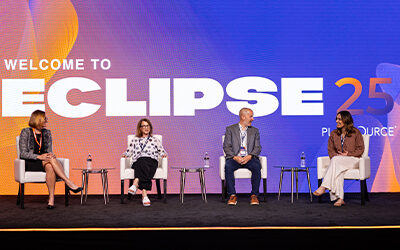Webinar Recap: Benefits Trends & Predictions HR Leaders Need to Know in 2022
Earlier in January, Cat Miller from PlanSource and Brad Mandacina from Lockton Companies sat down to discuss key Benefit Trends and Predictions HR Leaders Need to Know in 2022. Some of the most common trends that we hear about every year include modernization, APIs, big data and AI/ML technology. However, The Great Resignation shook things up and created new concerns including how to be more competitive with benefit offerings, how to combat employee turnover, and how to reach employees with benefit education. Keep reading to hear what Cat and Brad had to say about these hot topics and what they predict for 2022 in our webinar recap.
Rising Benefit Costs
Rising benefit costs is another “evergreen trend” that we hear about every year. These costs will continue to rise as we predict a 4-6% increase in 2022. We’ve recognized that many employers cite these rising costs as a main concern, so Brad reviewed key tactics to combat said expenses:
- Include HDHPs with HSAs in your benefits offering to not only combat high healthcare costs but to also promote healthcare consumerism among your employees
- Offer telehealth solutions that go beyond just medical care such as tele-therapy or tele-behavioral health to reduce costs on both the employer and employee sides
- Create a culture of wellness by hosting health-centered events such as yoga classes, fun runs or guided meditations
- Conduct dependent verification audits to ensure you’re only paying for dependents that are actually eligible
- Invest in a benefit decision support tool to help your employees choose the benefit plan that is right for them
The Great Resignation
HR teams are increasingly overloaded between the ongoing pandemic and the increase in turnover we saw in 2021. In November of last year, the number of job openings was at 10.6 million in the US. Between turnover, recruitment and increased pressure to retain talent, HR teams are feeling overwhelmed.
Managing day-to-day HR admin work, keeping employees happy and creating a talent retention strategy all while keeping benefit costs as low as possible seems like an impossible ask of HR teams. Cat explained that a great way to mitigate the impact of HR staff leaving is by outsourcing benefit administration tasks. Recruiting talent has become so competitive that it requires more HR attention and time than ever before. By outsourcing your benefits, there is more time available to do just that.
Gen Z Entering the Workforce
Right now, 40% of the workforce is made up of millennials and post-millennial generations. While Gen Z entering the workforce might not seem like a big deal, it’s important to recognize these people are the “first truly digital native generation that we have”. This means the way Gen Z communicates, searches for and applies to jobs and seeks education is different than previous generations before them.
When deciding on how to recruit talent, what benefits to offer or how to educate employees, we must keep Gen Z in mind because they are predicted to make up 27% of the workforce by 2025. Brad explains that there has been a shift in the benefits landscape to adding more unique benefit options because they appeal to Gen Z and Millennials. We expect these options to continue to grow in popularity as they make companies more attractive to young professionals.
Healthcare Consumerism
These newer generations have propelled a new way of thinking regarding how to buy and use benefits – they want a greater role in managing their own healthcare. By putting more power and responsibility in the hands of the participants, employees are more knowledgeable about their benefits thus saving money for both themselves and their employers.
The key to setting your employees up for success in healthcare consumerism is providing them with the education and decision-making tools they need. HR teams need to think digital and mobile first to make these tools as accessible as possible so it’s easy for employees to take a consumerist approach.
Diversifying and Expanding Benefits
Many companies are expanding their benefit offerings by adding voluntary benefits and extra benefits such pet insurance and ID theft protection. 94% of large employers believe voluntary benefits will be more important to their total rewards strategy going forward because they can create a sense of security for employees as well as reduce burnout.
While adding new benefits may feel like an additional burden on HR, your ben admin provider should be able to make this process easier. Best-in-class providers have strong carrier relationships that make adding new benefits a seamless experience. If you don’t have a ben admin provider or your current one hasn’t invested in those key relationships, check out our Complete Buyer’s Guide to Benefits Software to help you identify your specific ben admin needs.
Benefits Education
Brad explains “no matter how many benefits you offer, if you’re not educating your employees on them, they may not understand or value the benefits package you’re offering.” The stronger your education strategy, the more your employees will appreciate and use the benefits they have. Education also increases actual use of benefits which in turn creates a happier, healthier workforce.
81% of employees don’t open or read their benefit materials, and half that do don’t understand what they’re reading. So how is HR supposed to effectively educate? By expanding your strategy to include text messaging campaigns, video and/or decision support during the buying process, you can increase your number of touches and break through that barrier.
Need for a Flexible Ben Admin System
PlanSource customers offered 15 total benefits on average last year. We know that companies are continuing to change their total rewards package and it’s important to have a ben admin platform that can not only handle high levels of complexity but make changing or adding benefits easier as well.
Unique workforce populations, hybrid workspaces and compliance and regulation changes also drive this need for flexibility. If you aren’t sure how to find a ben admin partner who can do this for you, lean on your broker to guide you. Brad explains how all these trends mentioned drive this need for a flexible system and that brokers have taken on a more strategic role to help their clients navigate this.
Want to Learn More?
Watch our on-demand webinar to hear more from Brad and Cat to about these trends and how HR should be responding to them. Additionally, register for our upcoming webinar to learn about the benefits of benefit outsourcing and how it can allow HR teams to re-focus on attracting and retaining talent.
Empathy, Innovation & Action: Top Takeaways from HR Leaders Who Spoke at Eclipse
Empathy, Innovation & Action:Top Takeaways from the HR Leaders Who Spoke at...
Charting the Future of PlanSource: Our Vision for What’s Ahead
Discover how PlanSource unveiled game-changing AI innovations at Eclipse 2025, transforming how HR leaders manage benefits and how employees choose them. The future of benefits starts here.
Navigating New Requirements with the Paperwork Burden Reduction Act
Navigating New Requirements with the Paperwork Burden Reduction...




